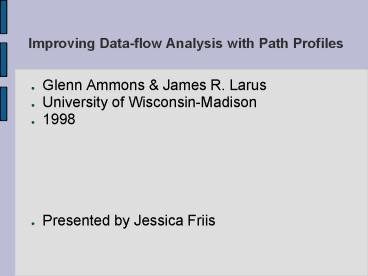Improving Dataflow Analysis with Path Profiles PowerPoint PPT Presentation
Title: Improving Dataflow Analysis with Path Profiles
1
Improving Data-flow Analysis with Path Profiles
- Glenn Ammons James R. Larus
- University of Wisconsin-Madison
- 1998
- Presented by Jessica Friis
2
Problem and Approach
- Some paths in a CFG are not run
- A small number of paths often make up a large
portion of the runtime - By duplicating some frequently used paths, we can
improve analysis on them
3
Outline
- Identify hot paths, frequently run paths in a
CFG by doing a training run on the program - Duplicate hot paths to form a new CFG, the Hot
Paths Graph, or HPG - The extra paths allow more precise analysis.
Constant propagation is looked at here - Reduce the graph to preserve only the valuable
solutions for the rest of compilation. - Implementation and Results
4
Example CFG
- Hot paths taken during sample executions
- A, B, C, E, F, H, I, X
- A, B, D, E, F, H
- B, D, E, G, H
- B, D, E, F, H, I, X
- Use Ball-Larus path profiles
- Chose paths so that they cover 97 of execution
time
5
Finite Automaton for the path profile
- The retrieval tree is used as a simple
representation of the automaton. - CFG edges label the transitions
- At 13, 15, or 16, a B takes you back to 0
- Anything else not labeled goes to an error state
- These extra states/edges are left out for
readability
6
Trace CFG and FA to get HPG
- Uses Holley and Rosen's data flow tracing
algorithm - The HPG will have nodes made up of a tuple v,q
where v is a vertex from the original CFG and q
is a state in the automaton - A worklist algorithm starts with r,q? where r
is the starting node in the CFG and q? is the
starting node in the automaton. It follows the
edges in the CFG and automaton to create a new HPG
7
New HPG
- The diagonally striped nodes (A0 and B0)
represent the beginnings of the forward paths - The shaded nodes represent the error states in
the automaton (paths that are not 'hot.') - Haven't lost any information from orginal CFG
8
New Knowledge with HPG
- At H14, ab6
- At H12, H15, ab5
- At H13, ab4
- At H14H15, i 1
- At I17, n is 1
- These are new constant results
9
Eliminate unneeded vertices
- Heuristic algorithm for identifying the most
valuable duplicated vertices. - Others can be reduced/combined to form rHPG for
further compilation.
10
Implementation
- Implemented as two new paths in SUIF compiler, PP
and PW - Compile into intermediate form
- PP pass instrumented intermediate form for path
profiling - Running the result gives us our path profile
- Next the intermediate code and the path profile
is run through PW - PW generates the HPG, discovers new constants,
and generates the rHPG - The output is compiled into an executable
11
Speedup of SPEC95 benchmarks
- The benchmarks with the most new constants found
sped up, the other slowed - The increase in program size causes the slowdown
12
Program Costs
- Cost of duplication in size of CFG ? HPG
- Go increased 184
- All others increasaed an average of 32
- Cost of duplication in size of CFG ? rHPG
- Go increased 77
- All others increased less than 10
- Analysis time
- Go took 6 times longer
- All others took an average of 61 longer
13
Contributions
- Shows improvements in the precision of data flow
analysis through guided duplication - Describes how to reduce hot path graphs
- Preserves path profiling information through
transformation from CFG to HPG to rHPG - Applies to constant propagation to show
performance increase
14
Issues
- The cost of analysis is significant
- Only should be used just before release
- The increased graph size slows down the running
time - Specific reasons are not known, but larger
program size is a possibility - They only tested with a single optimization
- Adding in other optimizations may give more
speedup gains
15
Questions?

